

Cathy
A 2020 Vision: Education in the next two decades. A 2020 Vision:Education in the next two decades James Levin University of Illinois Appeared in 2002 in the Quarterly Review of Distance Education, 3(1), 105-114.

Introduction It is difficult to predict the future. Potential EDUT 522 articles. 123D Catch Turns Pictures Into 3D Models. Google's Prototype "Smart Contact Lens": Measuring Blood Glucose Levels for People with Diabetes - VisionAware Blog. Earlier this year, Google unveiled a prototype "smart" contact lens to monitor blood glucose levels contained in human tears.
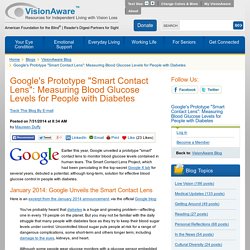
The Smart Contact Lens Project, which had been percolating in the top-secret Google X lab for several years, debuted a potential, although long-term, solution for effective blood glucose control in people with diabetes. January 2014: Google Unveils the Smart Contact Lens Here is an excerpt from the January 2014 announcement, via the official Google blog: You've probably heard that diabetes is a huge and growing problem—affecting one in every 19 people on the planet.
7 Ed Tech Trends to Watch in 2014. Technology trends in both higher ed and K-12 classrooms continue to evolve and transform traditional learning environments.
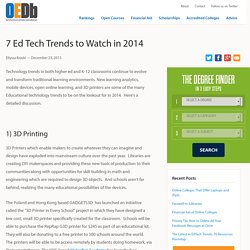
New learning analytics, mobile devices, open online learning, and 3D printers are some of the many Educational technology trends to be on the lookout for in 2014. Here’s a detailed discussion. 1) 3D Printing 3D Printers which enable makers to create whatever they can imagine and design have exploded into mainstream culture over the past year. Libraries are creating DIY makerspaces and providing these new tools of production to their communities along with opportunities for skill-building in math and engineering which are required to design 3D objects. Top 10 emerging technologies for 2014. Technology has become perhaps the greatest agent of change in the modern world.

While never without risk, positive technological breakthroughs promise innovative solutions to the most pressing global challenges of our time, from resource scarcity to global environmental change. However, a lack of appropriate investment, outdated regulatory frameworks and gaps in public understanding prevent many promising technologies from achieving their potential. The World Economic Forum’s Global Agenda Council on Emerging Technologies identifies recent key trends in technological change in its annual list of Top 10 Emerging Technologies. Is Google Making Us Stupid? Illustration by Guy Billout "Dave, stop.
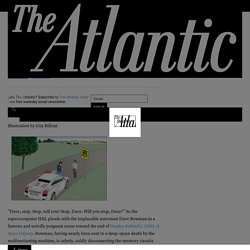
Stop, will you? 9 Characteristics Of 21st Century Learning. The Inside-Out School: A 21st Century Learning Model. The Inside-Out School: A 21st Century Learning Model by Terry Heick As a follow-up to our 9 Characteristics of 21st Century Learning we developed in 2009, we have developed an updated framework, The Inside-Out Learning Model.

The goal of the model is simple enough–not pure academic proficiency, but instead authentic self-knowledge, diverse local and global interdependence, adaptive critical thinking, and adaptive media literacy. By design this model emphasizes the role of play, diverse digital and physical media, and a designed interdependence between communities and schools. AR week 3. 3D Printing Will Transform Education. Manufacturing the future: How 3D printing went from pipe dream to your desktop. Documentary 'Print the Legend' Goes Inside the World of 3D Printing. The genesis of and challenges to the 3D-printing revolution are subjects that take center stage in a new documentary called Print the Legend.
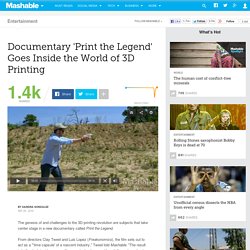
Four Ways Schools Will Be Different in 10 Years. Wearable Technology: will education look very different in the future? Wearable technology certainly seems to be gaining ground with many getting very excited about the variety of devices coming on the market.
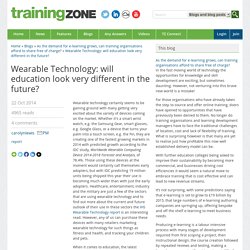
Whether it's a smart wrist watch, e.g. the Samsung Gear, smart glasses, e.g. Google Glass, or a device that turns your palm into a touch screen, e.g. the Fin, they are creating one of the fastest growing markets in 2014 with predicted growth according to the IDC study, Worldwide Wearable Computing Device 2014-2018 Forecast and Analysis, of 78.4%. Those using these devices at the moment would certainly call themselves early adopters, but with IDC predicting 19 million units being shipped this year their use is becoming much wider than with just the early adopters.
Miracles You’ll See In The Next Fifty Years. 10 predictions 1950s futurism got right and wrong about the year 2000. Google self-driving car has no steering wheel or brake. If you're uneasy at the idea of riding in a vehicle that drives itself, just wait till you see Google's new car.
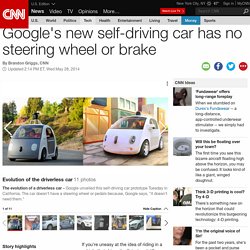
It has no gas pedal, no brake and no steering wheel. Google has been demonstrating its driverless technology for several years by retrofitting Toyotas, Lexuses and other cars with cameras and sensors. But now, for the first time, the company has unveiled a prototype of its own: a cute little car that looks like a cross between a VW Beetle and a golf cart. "They won't have a steering wheel, accelerator pedal, or brake pedal ... because they don't need them," Google said Tuesday in a blog post introducing the unnamed electric vehicles. "Our software and sensors do all the work. " Unlike previous models, these cars won't have human drivers monitoring them at all times. The Future of Education: Epic 2020.